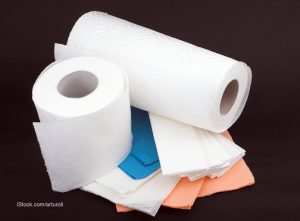I am, obviously, extremely conscious of food safety in the kitchen. I have had food poisoning twice in my life: once as a child after eating hard boiled eggs that were left at room temperature, and as an adult after eating candied pineapple. Those terrible experiences, and my education, have prompted me to help others avoid this horrible illness. I try to tell you about prompt refrigeration, cleaning methods, safe cooking and handling methods, and other factors that can affect your risk of getting food poisoning. This topic is not well covered: the safety of kitchen towels.
 A new study published in Food Protection Trends documents the presence of bacteria in kitchen sponges and dishcloths. Researchers looked at kitchen hand towels and tested them to see if they contain pathogenic bacteria. They found that coliform bacteria, which indicate the presence of fecal matter, was found on 89% of the towels sampled, and E. coli bacteria was found on 25.6% of the towels. That’s why I use paper towels in my kitchen.
A new study published in Food Protection Trends documents the presence of bacteria in kitchen sponges and dishcloths. Researchers looked at kitchen hand towels and tested them to see if they contain pathogenic bacteria. They found that coliform bacteria, which indicate the presence of fecal matter, was found on 89% of the towels sampled, and E. coli bacteria was found on 25.6% of the towels. That’s why I use paper towels in my kitchen.
The study says that “the moist environment and collected food residues [on the towels] create an ideal environment for the grown of bacteria.” The researchers conducted the study in Chicago, IL, Tucson, AZ, New Orleans, LA, Orlando, FL, and Toronto, ON, Canada. The cities were chosen to represent different weather conditions. Random households were selected in each city. Consumers were given surveys about their kitchen practices, and towels from their kitchens were collected and tested.
This study is the first of its kind to address concentrations and types of bacteria in kitchen hand towels. Interestingly, the relationship between the numbers of bacteria and the cities where the towels were collected was statistically significant. The highest number of bacteria per towel were found in the New Orleans samples, and the lowest in towels from Orlando.
One strange result from the study was that statistically significant lower numbers of HPC (heterotrophic bacteria counts) were found in towels that were washed less often. But E. coli numbers on towels were lower the more often they were washed. This suggests that E. coli is easily removed from the towels during washing. And coliforms, E. coli, and Salmonella can survive the drying of kitchen cleaning cloths and will regrow when the cloth becomes soiled again.
The researchers recommend frequent replacement or decontamination of kitchen towels. One study found that detergent washing and drying of kitchen cloths in the kitchen only slightly reduced microbial contamination, and regrowth occurred within 24 hours. Soaking the cloths in bleach for two minutes was more effective in reducing the number of bacteria. But not all cloths could be decontaminated, most likely because of differences in organic load. Other studies have found that boiling the cloths for 15 minutes does reduce bacteria numbers.
If you have a person in a high risk group in your household (elderly, children, those with compromised immune systems and chronic illnesses), think about using paper towels instead of cloth towels in your kitchen. This small change, while more expensive, could prevent a devastating illness in your family.




